Deer Mice: Peromyscus, Rice Rats: Oryzomys, Cane Mice: Zygodontomys, Cotton Rats: Sigmodon, White-Tailed Rats: Mystromys
1/48
There's no tags or description
Looks like no tags are added yet.
Name | Mastery | Learn | Test | Matching | Spaced |
|---|
No study sessions yet.
49 Terms
Peromyscus maniculatus
the prairie deer mouse
Peromyscus leucopus
The white-footed mouse
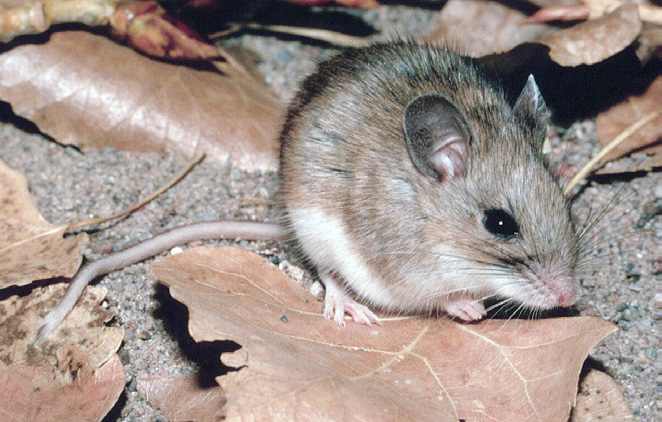
What is this?
Peromyscus leucopus, The white-footed mouse
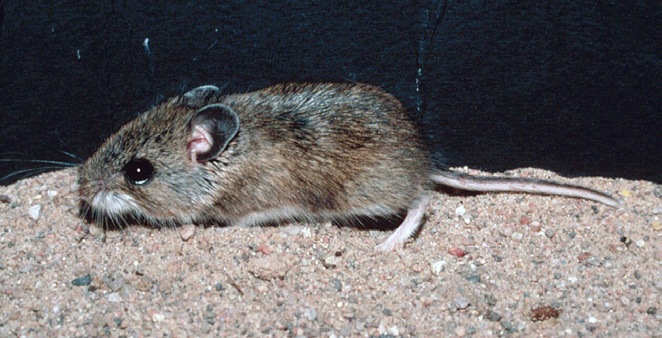
What is this?
Peromyscus maniculatus, Prairie Deer Mouse
Common research uses for Peromyscus species?
have been used extensively for studies in genetics, physiology, aging, cataracts, and behavior
What species if an inducible model for heritable hyperlipidemia?
Peromyscus californicus
are genetically susceptible to a heritable hyperlipidemia
that is inducible by a high fat diet. This has been used as an
experimental model of metabolic syndrome.
What specific neurologic research are Peromyscus good for?
neurological research of epilepsy and refine methods for generating audiogenic seizures have been developed
What zoonotic disease is P. leucopus best known to be a reservoir for? HINT: present in North America, aerosolized dust with mouse urine is common cause of zoonosis in humans
They are well known as the principal vector for North American hantaviruses, including Sin Nombre virus
BSL level required when hantavirus is induced in Deer mice, white footed mice or cotton rat?
BSL 4
BSL level required when hantavirus is induced in other rodents except Deer mice, white footed mice or cotton rat?
BSL 2
What parasite is P. leucopus a host for and what zoonotic diseases does this vector spread?
P. leucopus is a significant host for Ixodes scapularis (the black-legged tick or deer tick). Thus it has been studied for its role in the epidemiology of Borrelia burgdorferi, the causative agent of Lyme disease. Ixodid ticks also are host to the blood parasites Babesia microti and Anaplasma phagocytophilum (formerly Ehrlichia phagocytophila)
What zoonotic diseases are P. leucopus commonly vectors for?
Hantavirus (Sin Nombre)
Tickborne diseases (Lyme, anaplasma, babesia)
tularemia
toxoplasmosis
trypanosomiasis
cryptosporidium
giardia
Activity, estrus, gestation of Peromyscus?
Nocturnal, estrus is 6 days and typically are polyestrus, gestation 22-23 days.
Oryzomys palustris
Oryzomys palustris is the most commonly studied species.
It is also called the marsh rice rat because it is found
in habitats such as swamps and salt marshes.
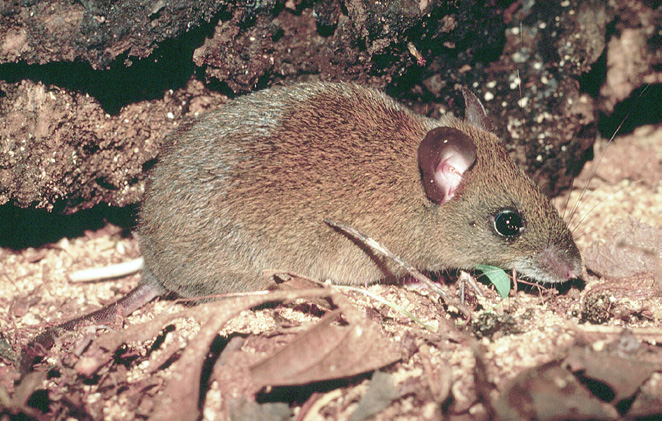
What is this?
Oryzomys palustris, Marsh rice rat
What are rice rats most commonly used for on research?
The rice rat spontaneously develops periodontal disease. The rice rat spontaneously develops periodontal disease
How is periodontitis induced in rice rats?
The rice rat spontaneously develops periodontal disease
Rice rats have chromosome polymorphism, what does that mean?
varying diploid numbers for total chromosomes
What are rice rats common zoonotic vectors for?
The rice rat is the predominant reservoir
host for Bayou virus, a cause of hantavirus pulmonary
syndrome
Zygodontomys brevicauda
Cane mouse
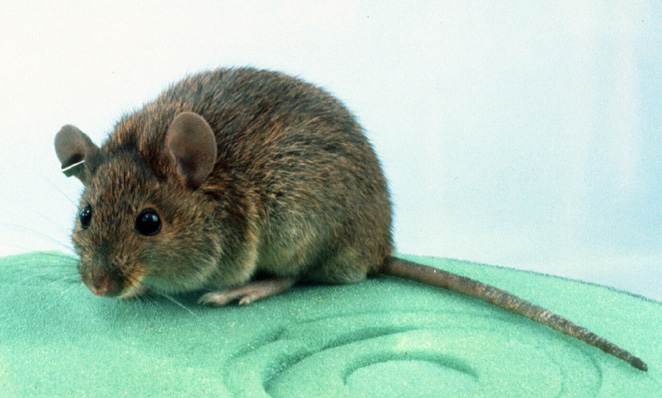
What is this?
Zygodontomys brevicauda, cane mouse
What are Zygodontomys brevicauda used in research for?
comparative studies of mammalian
circannual reproductive cycles since this is one
of the few tropical species known to lack a reproductive
response to photoperiod
What zoonotic virus are Zygodontomys brevicauda natural host for?
Zygodontomys brevicauda is a
natural host of Guanarito virus, the cause of Venezuelan
hemorrhagic fever (VHF)
What is the diet for Z. brevicauda?
Food consisted of commercial mouse chow, supplemented by dry
cat food and chopped frozen vegetables
What behavioural trait regarding handling should you know about Z. brevicauda?
Cane mice are strong and agile and jump abruptly with slight provocation
What parasite is significant in research colonies of Z. brevicauda?
tropical rat mite (Ornithonyssus bacoti) appears
to persist in laboratory-bred, wild-derived animals
Sigmodon hispidus
cotton rat
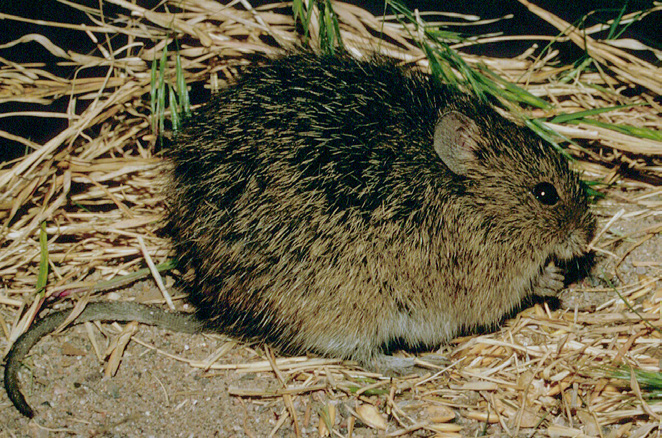
What is this?
Sigmodon hispidus
S. hispidus are commonly used in what kind research?
Cotton rats are an important animal model for viral
respiratory tract diseases, particularly those caused by
paramyxoviruses. ie. RSV, Parainfluenze 3, and measles virus. Additionally, also good models for avian and swine influenza and have been used to test influenza vaccination strategies
S. hispidus become or immune or predisposed to enhanced disease when receiving paramyxoviral vaccines?
enhanced disease
Why are cotton rats good models for adenovirus?
Adenovirus pneumonia in infected animals is similar to that in humans. Ocular adenovirus infection in cotton rats is the only animal model of epidemic keratoconjunctivitis
What zoonotic diseases are cotton rats hosts for?
Rickettsia tsutsugamushi, the causative agent of scrub typhus.
Cotton rats are naturally infected with the
filarial nematode Litomosoides carinii and are popular animal models to screen antifilarial drugs
They can be nasally colonized with methicillin-resistant Staphylococcus aureus (MRSA) to test interventional strategies.
Researchers have investigated the role of the
wild cotton rat as a natural reservoir of Lyme disease,
the hantavirus Black Creek Canal virus, and Venezuelan
equine encephalitis
Are cotton rats aggressive?
Aggressive behavior is common, and caged animals will inflict severe bite wounds on cage mates and sometimes fight to the death. The cotton rats will attempt to bite and escape when
picked up. Leather garden gloves simplify handling but
for inexperienced handlers, a handling device enabling
cage transfer without direct contact has been developed
Activity, estrus, gestation of cotton rats, breeding behaviour?
Diurnal, solitary animals, gestation is 27 days. Monogamous breeding by 6 weeks of age.
Do cotton rats require a lot of water?
Animals drink more than standard
laboratory rats, thus caretakers may need to change
cages twice a week.
Diet for cotton rats?
standard rodent diet fine
What happens when you handle cotton rats by the tail?
Cotton rats should not be picked
up by the tail, as they spin when picked up and the tail
skin easily degloves.
What is a notable neoplastic disease of cotton rats?
fundic gastric tubular adenocarcinoma
What do inbred colonies of cotton rats tend to get?
sporadic exophthalmos and heart failure
Mystromys albicaudatus
white tailed rat
Are Mystromys albicaudatus rats?
No they are actually hamsters
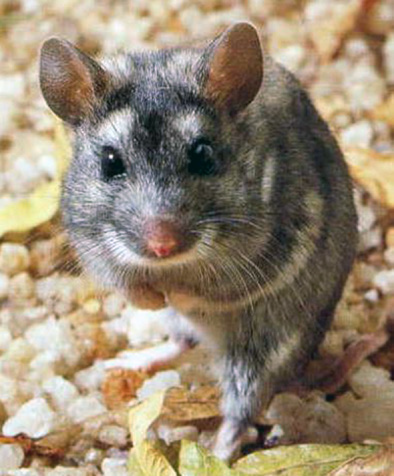
What is this?
Mystromys albicaudatus
What rudimentary anatomic feature of Mystromys albicaudatus do females have?
Females have a rudimentary prostate gland
What metabolic disease are Mystromys albicaudatus models for?
white-tailed rats were used in diabetes
mellitus research where they have been demonstrated
to spontaneously develop hyperglycemia, polyuria,
glycosuria, ketonuria, and degenerative changes in the
islets of Langerhans. The disease is more common in
males and is not associated with obesity
What infectious diseases are M. albicaudatus models for?
have been infected experimentally with Crimean–Congo
hemorrhagic fever virus
They have also been infected with human Streptococcus spp. to investigate caries development
an excellent model of American cutaneous leishmaniasis
Do young attach to mystromis nipples after birth?
Newborns attach firmly to the nipples
of the dams and are dragged about for 3 weeks
Gestation of the white tailed rat?
38 days
White tailed rat diet?
standard rodent diet
Is spontaneous DM more common in males for females?
Spontaneous diabetes mellitus in the white-tailed
rat is common is more frequent in males than in
females